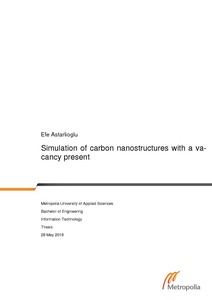Simulation of carbon nanostructures with a vacancy present
Astarlioglu, Efe (2018)
Astarlioglu, Efe
Metropolia Ammattikorkeakoulu
2018
All rights reserved
Julkaisun pysyvä osoite on
https://urn.fi/URN:NBN:fi:amk-2018060312169
https://urn.fi/URN:NBN:fi:amk-2018060312169
Tiivistelmä
Carbon is a very special element given it can take part in millions of different chemical compounds due to its 4 valence electrons and its compact size to fit in larger molecules. Further, carbon forms allotropes. Most familiar allotropes of carbon are diamond and graphite. Graphene and carbon nanotube will be the two allotropes of carbon which will be the subject in this project.
Both graphene and carbon nanotubes have unique mechanical, thermal, optic and electrical properties. Therefore, they are either in use, or can potentially be used, in myriad different applications in industries or research. Consequently, it is important for future development to understand the behavior of these allotropes in diverse settings.
Main task of this project was to investigate the behavior and effect of vacancy defects (point defects) in graphene sheet and carbon nanotube of different sizes as a function of temperature. In order to study these behavior and effects, computer simulations on molecular dynamics were employed. This report will introduce the necessary chemistry and material science concepts as well as tools used in simulation of the structures.
As a result of the simulations, diffusion of vacancies in the structures was observed. The simulations ran with a resolution of 1 femtoseconds in which the structures were heated from 0K to upwards of 4500K.The diffusions took place at high temperatures for both graphene and carbon nanotube.
Both graphene and carbon nanotubes have unique mechanical, thermal, optic and electrical properties. Therefore, they are either in use, or can potentially be used, in myriad different applications in industries or research. Consequently, it is important for future development to understand the behavior of these allotropes in diverse settings.
Main task of this project was to investigate the behavior and effect of vacancy defects (point defects) in graphene sheet and carbon nanotube of different sizes as a function of temperature. In order to study these behavior and effects, computer simulations on molecular dynamics were employed. This report will introduce the necessary chemistry and material science concepts as well as tools used in simulation of the structures.
As a result of the simulations, diffusion of vacancies in the structures was observed. The simulations ran with a resolution of 1 femtoseconds in which the structures were heated from 0K to upwards of 4500K.The diffusions took place at high temperatures for both graphene and carbon nanotube.
